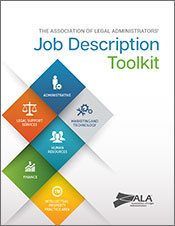Articles & Posts
These webinars discuss how the UPBMS is being put to use.
Introduction to the ALA UPBMS Uniform Process Based Management System: 1st Installment
Uniform Process Based Management System Early Adopters (UPBMS): 2nd Installment
This podcast talks about the ways the UPBMS will change how we look at legal management.
Creating a UPBMS Taxonomy for the Legal Industry
alanet.org/education/online-learning/
podcasts/creating-a-upbms-taxonomy-for-the-legal-industry-with-bill-mech
ALA's Legal Management recently provided an overview of what's been updated in Version 2.0 of the UPBMS and how it was put to use in the ALA Job Description Toolkit.
Unified Approach: ALA's UPBMS is filling a void and providing a standard for classifying legal operations.
legalmanagement.org/features/unified-approach
This blog post by Jim Hassett, Jonathan Groner, and Steve Barrett, discusses the best use of task codes. While their research is primarily focused on practice related activities, it has many parallels to those seeking to utilize the UPBMS.
Task codes and budgeting: What works and what doesn’t
(Part 1 of 7)
adverselling.typepad.com
This Legal Technology News article discusses standardization in technology solutions used by law firms. This is an illustration of how a standardized taxonomy like the ALA UPBMS can be applied.
At Law Firms, Customization is No Longer King: The Resurgence of Standardized Solutions
legaltechnews.com/
id=1202757359572/At-
Law-Firms-Customization-is-No-Longer-King-The-
Resurgence-of-Standardized-Solutions#ixzz48ebCUzBD
This Legal Rebels post discusses innovation within a law practice. While the post does not specifically discuss an application for the UPBMS, many of the issues discussed apply to innovation efforts involving their application.
Overcoming fixedness: How thinking ‘inside the box’ can drive innovation
abajournal.com/legalrebels/
article/overcoming_ fixedness_thinking_inside_the_
box_can_drive_innovation
This Above The Law survey of small-solo law firm management conducted by the Thomson Reuters Solo and Small Law Firm group contains several interesting statistics regarding operations and priorities. One of the most applicable to the UPBMS is the data that reveals the average respondent spends 39% of their time performing non-practice activities.
Analyzing the non-practice time of attorneys is a common use of the UPBMS codes. If those tasks can be identified and quantified, they can be effectively managed, and minimized.
abovethelaw.com/2016/07/this-week-in-legal-tech-exclusive-results-of-a-new-small-firm-survey
